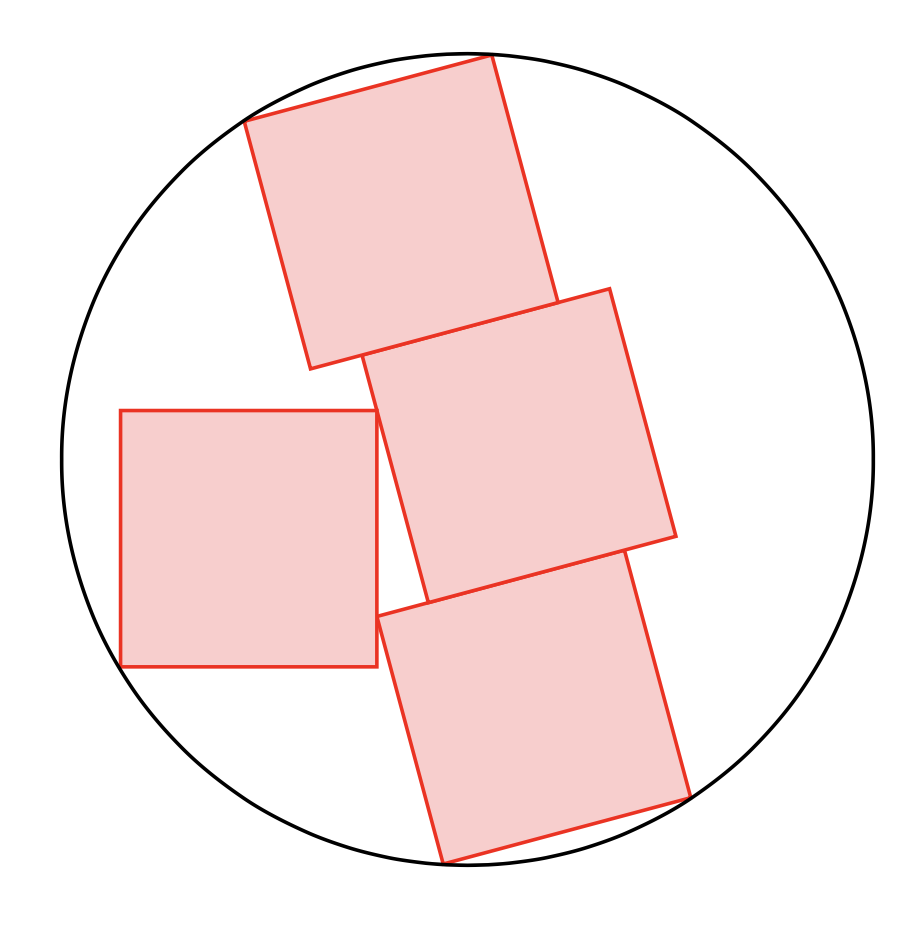This draws such a picture. However, it does not answer the question how to construct the smallest circle that fits the boxes. Rather, it relies on the user selecting the three relevant coordinates.
```
\documentclass[tikz,border=3mm]{standalone}
\usetikzlibrary{calc,through}%
\tikzset{circle through 3 points/.style n args={3}{% https://tex.stackexchange.com/a/461180
insert path={let \p1=($(#1)!0.5!(#2)$),
\p2=($(#1)!0.5!(#3)$),
\p3=($(#1)!0.5!(#2)!1!-90:(#2)$),
\p4=($(#1)!0.5!(#3)!1!90:(#3)$),
\p5=(intersection of \p1--\p3 and \p2--\p4)
in },
at={(\p5)},
circle through= {(#1)}
}}
\begin{document}
\begin{tikzpicture}
\begin{scope}[local bounding box=boxes,
nodes={draw=red,fill=red!20,minimum size=1cm}]
\path[rotate=15,transform shape] node (a){} (a.70) node[anchor=south] (b){}
(b.110) node[anchor=south] (c){};
\path (a.north west) coordinate (p1) ++ (0,1) coordinate (p2)
(b.south west) coordinate (p3) (b.north west) coordinate (p4)
(intersection of p1--p2 and p3--p4) node[anchor=north east] (d){};
\end{scope}
\path node[draw,circle through 3 points={a.south east}{c.north east}{d.south west}]
(C){};
\draw (C.south-|C.west) rectangle (C.north-|C.east);
\end{tikzpicture}
\end{document}
```

If five corners are supposed to touch the circle, there is one free parameter. The radius can be computed from the requirement that three corners of the stacked boxes (called `(a)` and `(c)` in the code below) lie on the circle, and the fourth corner is then automatically on the circle. The radius is then given by `R=sqrt(10)*a/2` (thanks to [Jairo A. del Rio](https://topanswers.xyz/transcript?room=347&id=93943#c93943)), where `a` is the length of an edge of the cube. The fourth cube, `(d)` can be rotated and moved along its edge, which determines the shift of the middle box, `(b)`. It is clear that there is a continuous parameter, and it appears likely that there is a favorable parametrization that allows one to find very simple expressions for the rotation angle as a function of the shift, say, but I did not have the passion to try to find one. So for the time being I just add an example where this relation has been guessed.
```
\documentclass[tikz,border=3mm]{standalone}
\usetikzlibrary{calc}%
\begin{document}
\begin{tikzpicture}[declare function={a=1;R=sqrt(10)*a/2;phi=15;}]
\begin{scope}[local bounding box=boxes,
nodes={draw=red,fill=red!20,minimum size=a*1cm,outer sep=0pt}]
\path[rotate=phi,transform shape] node (a){}
([xshift={a*sin(4*phi/5)*1cm}]a.north) node[anchor=south] (b){}
([xshift={-a*sin(4*phi/5)*1cm}]b.north) node[anchor=south] (c){};
\path (a.north west) coordinate (p1) ++ (0,1) coordinate (p2)
(b.south west) coordinate (p3) (b.north west) coordinate (p4)
(intersection of p1--p2 and p3--p4) node[anchor=north east] (d){};
\end{scope}
\draw ($(a)!0.5!(c)$) circle[radius=R];
\end{tikzpicture}
\end{document}
```

Essentially copying the strategy from [Jairo A. del Rio](https://topanswers.xyz/transcript?room=347&id=93943#c93943), one can then draw the figure in a single path. The intersections of the lines with the circle are computed analytically, hence the `atan2` and the `acos`, and the others with `calc`, which also allows us to add some useful projections. `phi` is the angle by which the stacked boxes get rotated, which we take to be the free parameter of this setup.
```
\documentclass[tikz,border=3mm]{standalone}
\usetikzlibrary{calc}%
\begin{document}
\foreach \Angle in {2,...,30,29,28,...,3}
{\begin{tikzpicture}[declare function={a=1;d=0.1;R=sqrt(10)*a/2;
phi0=atan2(1,3);phi=\Angle;}]
\draw[nodes={draw=red,fill=red!20,minimum size=a*1cm,outer sep=0pt}]
(-90-phi0+phi:R) node[anchor=south west,rotate=phi](a){}
(90+phi0+phi:R) node[anchor=north west,rotate=phi](c){}
let \p1=(a.north west),\n1={acos((a*1cm-\x1)/(R*1cm))} in
(180+\n1:R) node[anchor=south west](d){}
($(a.north west)!(d.north east)!(a.north east)$)
node[anchor=south west,rotate=phi](b){}
(0,0) circle[radius=R];
\end{tikzpicture}}
\end{document}
```
